
In this blog the alignment of optical systems with a Fizeau interferometer is discussed.
The goal of a system wavefront test is alignment and confirmation of system performance. The measurement of optical system wavefront often requires a custom interferometer. When a fully reflective system is measured a standard HeNe laser Fizeau is sufficient as the wavelength does not matter. For refractive systems the wavelength often must match the optical system design, and optical system wavelengths vary from 10.6 um to 193 nm. Thus these systems are often “custom” except for a few wavelengths that are more common. For this discussion the wavelength is assumed to be matched to the system.

Null Test
If a null, adjust until near-zero error is the goal then a standard continuous zoom system can be sufficient. At null ray trace errors are minimized and wavefront imaging distortion error minimal. Further mid-spatial frequency errors are not critical when measuring system alignment. Some of these measurements are made with a null corrector lens that matches the system under test wavefront with the interferometer expected wavefront, either spherical or plano.
Non-Null Testing
Subsystem testing can produce non-null wavefronts in the final alignment. For non-null system an interferometer with low ray-trace errors is important. With high fringe density, or high slopes, ray trace errors grow. Ray-trace errors are developed when the test and reference wavefront traverse diverging paths to the camera and are seen primarily as coma and astigmatism, with sometimes spherical errors. If the final “aligned” condition is at 10 waves of spherical aberration then unless the interferometer is well corrected for ray-tracing errors the data will exhibit errors in final alignment.

Small systems
A bench top system test is similar to measuring an optical component and standard phase shifting data acquisition is sufficient.
Real Time Adjustment
Recently the introduction of widely available simultaneous data acquisition interferometers have enabled near real time phase. So alignments can be adjusted continuously for more rapid convergence on alignment.
Large Systems
For large systems, typically telescopes, vibration and turbulence become an issue. If an issue then only a simultaneous phase measuring system will be able to acquire data.
Summary
In most cases a standard interferometer with near matching wavelength is sufficient to test optical system wavefront. Where large or non-nulled cavities are involved a high performance interferometer with low ray-trace errors and/or simultaneous phase measurement need to be used.
Next Post: Small tool polishing applications